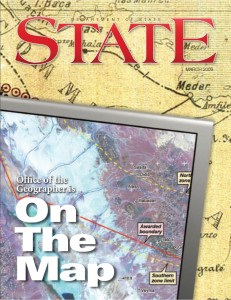This year’s Free and Open Source for Geospatial (FOSS4G) North America event was held in Raleigh, NC between May 2-5, 2016. Attendance increased by 150+ over last year, bringing the total to over 550 registrations. While typically a developer conference with technical software presentations, recent years has seen an increase in participation (both attendance and presentations) from the user community. This year continued that trend, and the agenda included a wide array of topics. In addition to good facilities and well run logistics, the program committee did an excellent job curating the presentations; nearly all of the sessions I attended were appropriate content and well delivered, a feat for any conference. A full list of the attended sessions I attended is in the table at the end of the post.
Below are some of my takeaways from the conference, categorized into three general themes: Tools, Data, and Visualization.
Tools
It is clear that open source software continues to mature, and when combined with new deployment technologies like Docker containers and cloud, it is a fundamentally different world than a few years ago. This is clearly not a ground shaking statement, but the speed by which anyone can go from zero to a cloud-deployed, scalable geographic computing infrastructure is amazing.
Machine Learning is everywhere. Granted I haven’t used ML approaches in a few years, but my concern is that simpler approaches of statistical modeling are being overlooked just to use the big, new shiny thing. The underlying assumption with ML is that all problems are solved best through inductive methods, which potentially discounts the wisdom of domain expertise. ML is obviously very powerful when lots of data is available and should be part of the modelling toolkit, but it’s not a magic bullet and mis-applications are going to become more common. Using TensorFlow or the other new algorithms doesn’t fundamentally change the need to understand how statistics and modeling works, and modelers need to be aware of the full range of statistical tools.
On the Natural Language Processing (NLP) and geocoding side, GeoParser could be key bridge between the document open data and geospatial open data communities. Combining tools like Apache Tika, Stanford NLP, and Gazetteer lookup means there is a single toolkit with the potential to geocode any document. Clearly geocoding results here are limited in success to the quality of the gazetteer, but the processing pipeline is interesting.
The Geo Big Data processing tools continue to mature and are even starting to converge on the use of underlying libraries and database. This collection of tools includes GeoWave, GeoTrellis, GeoMesa, GeoJinni. Personally I’m interested in the use of GeoTrellis for high-performance raster modeling.
Sensors are expanding everywhere: agriculture best example of persistent, integrated data collection across sensors (imagery, lidar, IoT) and application into “smart” devices (self-driving farm equipment and custom planting / harvesting strategies). OpenSensorHub can be used to integrate various feeds, thinking of applications with automated hydromet, weather, and seismic stations, as well as other crowd reported data feeds.
Data
Vector tiles expand market share: nascent analytical capability, new version 2.0 specification, true 3D in the tile (when comes 4D), added to GeoServer
Remote Sensing is big: Cubesats, Drones, Imagery, Point Clouds all continue to grow and expand into all market verticals (farming, logistics, business analysis leading the way)
Remote Sensing is still hard: massive imagery catalogs only further expose fundamental remote sensing issues on analysis (orthorectification and image-to-image registration, atmospheric effects on spectral reflectance); drones and kites driving new photogrammetric toolkits; the cool kids are yet to fully catch on to these challenges.
OSM ecosystem continues to deepen and expand: Portable OpenStreetMap, or POSM, is a nice tool for enabling disconnected editing in austere environments. The upgraded HOT Export Tool is a key part of exporting the initial datasets used for the process. The critical question is how to get data back into OSM. Currently all edits are manually reviewed, using an interesting queuing mechanism that maintains individual changesets, and then uploaded using an import account. The question is how will the method scale when remote mapping is occurring at the same time as field mapping, the potential disconnect between edit histories of the disconnected branch can and will be an issue.
Visualization
Vector tiles is driving more client side rendering. Mapbox obviously leading the way here, but Boundless now supporting vector tiles in GeoServer and OpenLayers.
Seamless 2D/3D visualization: Cesium is everywhere, TerriaJS interesting library to add better visualization on top of spatial data catalogs; USGS/NASA GIBS adding atmospheric data slices into dense imagery catalogs. When do we get 4D tiles and/or tiles with multiple versions of the same dataset?
Imagery is driving client side visualization and nascent imagery exploitation tools in the browser
Convergence of ground based and aerial based views: “painted” 3D models from photogrammetric extraction combined with Mapillary type imagery; farm management using ground and aerial lidar clouds.
Sessions
Each of the links below go to the FOSS4G session page, many of which have links to the slidedecks and in the coming weeks will have the video recording of the presentation.
In the next post, I’ll cover the workshop section of the conference.


